Commissioning Information>> Gemstones

Diamonds, Sapphires, Rubies & other Gemstones
I often incorporate gemstones into my designs using stones which are sourced from reputable merchants who guarantee that their gemstones are conflict free.
There are various options to consider when choosing a stone. The majority of stone set pieces I create incorporate either diamonds, sapphires (available in a wide range of colours, not just blue!) and rubies because of their hardness and ability to withstand everyday wear. This makes them particularly suited for rings designs, especially wedding and engagement rings or others that are intended to be worn everyday for a long time (further details below). There are a range of possibilities including type, shape, size, colour and quality of gemstone.
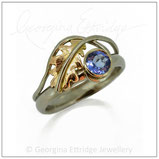
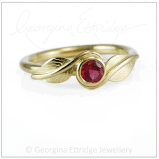
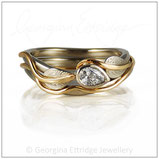
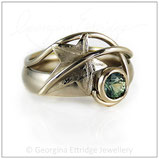

Gemstones can be set in various ways. I tend to use round, oval and pear shaped gemstones as I find that they lend themselves to the organic flowing lines of my designs, but occasionally I use other shapes. Whether they are set into the curls of the tendrils or a rub-over or claw setting, they can be used to enhance a design with their size, quality and colour or be used to represent something. For instance, birthstones can be chosen to represent your birthday or family members birthdays.
If you have your own gemstones these can be considered for inclusion for sentimental or environmental reasons. Please get in contact to discuss things further.
Diamonds
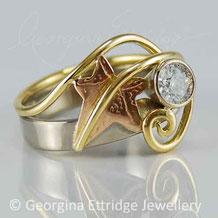
Diamonds are the hardest naturally occurring substance found on Earth. All diamonds are sourced from reputable suppliers that adhere to the Kimberley Process, providing the assurance that all diamonds are conflict free.
The price of a diamond, as with all gemstones, is affected by the colour, clarity, cut, and carat (weight), commonly known as the four C's. Generally diamonds larger than 0.25ct are certified and smaller ones are not. Certification, means that a diamond has undergone quality analysis by a trusted gemological laboratory such as the GIA (Gemological Institute of America) and have been issued with a certificate. This is a grading system recognised worldwide.
Coloured Sapphires & Rubies

A good alternative to a diamond is a sapphire or ruby. They are hard wearing and also available in a range of colours. Sapphires are precious gemstones that are widely known to be blue (ranging from dark blackish blue to light cornflower blue) but are also available in other colours such as pink, purple, yellow, lilac, green, white, black and even orange. A sapphire is a variety of mineral called corundum, with the red colour known as a ruby. Only small amounts of colouring trace elements separate rubies from other colours of sapphires. On the Moh's scale of hardness which is defined by a minerals resistance to scratching, where 1 is the softest and 10 is the hardest, diamonds rate as 10 and sapphires 9.
Other Gemstones
Other gemstones can be incorporated. Ones that are below a 9 mohs hardness are more susceptible to wear. Different types of gemstones have different characteristics so not all gemstones are suitable for every type of setting. For instance, emeralds often have internal fractures so aren't ideal for settings where a lot a pressure is required to set them. If there is a particular gemstone or colour you are interested in I am more than happy to discuss the various options but there are some further details below..
Mohs Hardness Scale:
Gemstones are rated on the Mohs Hardness Scale with 10 being the hardest. As explained above Diamonds and sapphire are the most durable to wear. In fact although topaz is the next hardest stone (rated at 8) , sapphires and rubies are twice as hard. Gemstones of 7 and below are very susceptible to scratching through everyday wear and grit and dust will abrade them overtime. There is nothing wrong with using softer stones in jewellery but the wearer needs to be mindful that they need more care and will not withstand everyday wear like diamonds, sapphire and rubies do.
- 10. Diamonds
- 9. Sapphire & Rubies
- 8. Topaz
- 7.5-8 Emerald, Aquamarine & Spinel
- 7-7.5 Tourmaline
- 7 Tourmaline (7-7.5), Peridot (6.5-7) and Quartz which includes Amethyst, Agate, Carnelian & Citrine (7)
- 6.5-7.5 Garnet (hardness is dependant on the type of garnet)
- 6-7 Moonstone, Labradorite, Opal, Tanzanite, Jade
Using your own Gemstones:
If you are interested in the possibility of using your own gemstones there are certain considerations. Please visit the 'Heirloom Redesign' page which goes into more detail.
You may also find some of the other
'Commissioning Information' pages of interest including 'Commissioning Process', 'Sizing Information', 'Precious Metal & Hallmarks', 'Gemstone Information', 'Heirloom Redesign' and 'Enquiry Forms'.
I hope these have been of help and I look forward to discussing your commission.
For inspiration please also visit the 'Bespoke Gallery' pages.
